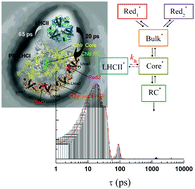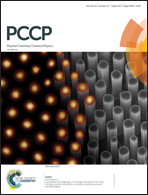Kinetics and heterogeneity of energy transfer from light harvesting complex II to photosystem I in the supercomplex isolated from Arabidopsis†
Abstract
State transitions are a phenomenon that maintains the excitation balance between photosystem II (PSII) and photosystem I (PSI–LHCI) by controlling their relative absorption cross-sections. Under light conditions exciting PSII preferentially, a trimeric LHCII antenna moves from PSII to PSI–LHCI to form the PSI–LHCI–LHCII supercomplex. In this work, the excited state dynamics in the PSI–LHCI and PSI–LHCI–LHCII supercomplexes isolated from Arabidopsis have been investigated by picosecond time-resolved fluorescence spectroscopy. The excited state decays were analysed using two approaches based on either (i) a sum of discrete exponentials or (ii) a continuous distribution of lifetimes. The results indicate that the energy transfer from LHCII to the bulk of the PSI antenna occurs with an average macroscopic transfer rate in the 35–65 ns−1 interval. Yet, the most satisfactory description of the data is obtained when considering a heterogeneous population containing two PSI–LHCI–LHCII supercomplexes characterised by a transfer time of ∼15 and ∼60 ns−1, likely due to the differences in the strength and orientation of LHCII harboured to PSI. Both these values are of the same order of magnitude of those estimated for the average energy transfer rates from the low energy spectral forms of LHCI to the bulk of the PSI antenna (15–40 ns−1), but they are slower than the transfer from the bulk antenna of PSI to the reaction centre (>150 ns−1), implying a relatively small kinetics bottleneck for the energy transfer from LHCII. Nevertheless, the kinetic limitation imposed by excited state diffusion has a negligible impact on the photochemical quantum efficiency of the supercomplex, which remains about 98% in the case of PSI–LHCI.



 Please wait while we load your content...
Please wait while we load your content...